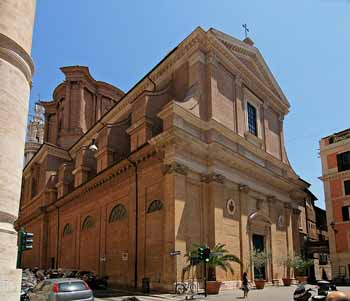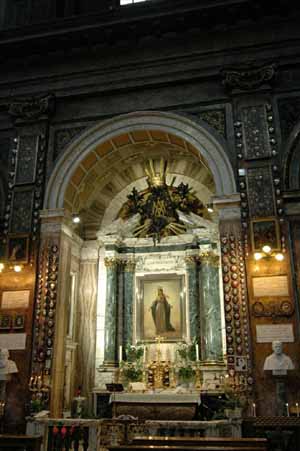 |
Catholic Virtues
Alphonse Ratisbonne’s Conversion - I
Theodore de Bussières
After reading the observations by Prof. Plinio Correa de Oliveira on the Madonna del Miracolo, some of our readers have expressed a desire for more details about this splendorous miracle of Our Lady and the consequent conversion of Alphonse Ratisbonne. In response to this request, TIA asked Mr. Patrick Odou to read a text written by Baron Theodore de Bussières, the man who was with Ratisbonne on that day and who was instrumental in his conversion.
Below is Odou’s selection from Bussières’ original narrative written in 1842 entitled, The Conversion of Marie-Alphonse Ratisbonne. The book, at a certain point, takes the form of a diary. A piece of information not included in this report but useful to understand is that Mr. Laferronnays, the friend of Bussières who had just died, had offered his life for the conversion of Ratisbonne. TIA
In the entry dated January 20, 1842, the very day of his conversion, we read: Alphonse Ratisbonne had not made the advance towards the truth; his will is inflexible as ever, he turns everything into ridicule and seems to mind only earthly things. About noon he went into a café on the Piazza di Spagna to read the newspapers. There he found my brother-in-law, Edmund Humann; they chatted over the news of the day with a flippancy and an ease that excluded all idea of any serious preoccupation of mind.

Façade of the Church Sant’Andrea delle Fratte |
It seems as if it had pleased Providence to order things so as to exclude the possibility of doubt as to Ratisbonne’s state of mind just before the unexpected grace of his conversion. About half-past twelve, as he came out of the café, he met his friend the Baron de Lotzbeck and entered into conversation with him on the most frivolous matters. He spoke of dancing, of pleasure, of the party given by Prince T. Had anyone said to him at that moment, within two hours you will be a Catholic, he would certainly have thought him not of his senses.
It was about one o’clock. I had to make some arrangements at the Church of S. Andrea delle Fratte for the ceremony of the morrow. But here is Ratisbonne coming down the Via Condotti; he will go with me, wait for me a few minutes, and then we will continue our walk. We entered the church. Ratisbonne noticed the preparations for a funeral, and asked for whom they were made.
“For a friend I have just lost, and whom I loved exceedingly, M. de Laferronnays.”
He then began to walk about the nave, and his cold indifferent look seemed to say, “This is certainly a very ugly church.” I left him on the epistle side of the church, to the right of a small enclosure destined to receive the coffin, and went into the monastery.
I had only a few words to say to one of the monks – I wanted a tribune prepared for the family of the deceased; my absence could not have been more than 10 or 12 minutes.
When I came back into the church I saw nothing of Ratisbonne for a moment; then I caught sight of him on his knees, in front of the lateral altar of St. Michael the Archangel. I went up to him, and touched him three or four times before he became aware of my presence. At length he turned toward me, his face bathed in tears; he joined his hands and said, with an expression which no words will render: “Oh, how this gentleman [M. de Laferronnays] has prayed for me!”
I was quite petrified with astonishment; I felt what people feel in presence of a miracle. I raised Ratisbonne, I led him, or rather almost carried him, out of the church; I asked him what was the matter, and where he wished to go.
“Lead me where you please,” cried he; “after what I have seen I obey.”

“...and in the midst of that radiance I saw standing on the altar loft, clothed with splendor, full of majesty and sweetness, the Virgin Mary.” |
I urged him to explain his meaning, but he could not; his emotion was too mighty and profound. He drew forth from his bosom the miraculous medal, and covered it with kisses and with tears. I brought him back to his apartment; and notwithstanding my repeated questions, I could get from him nothing but exclamations, broken by deep sobs:
“Oh, what bliss is mine! How good is the Lord! What a fullness of grace and of happiness! How pitiable the lot of those who know not!”
Then he burst into tears at the thought of heretics and disbelievers. At length he asked me if I did not think him mad. “But no,” he exclaimed, “I am in my right senses. My God, my God, I am not beside myself. Everyone knows that I am not mad!”
This wild emotion became gradually calmer, and then Ratisbonne threw his arms around me and embraced me. His face was radiant, I might almost say transfigured. He begged me to take him to a confessor; wanted to know when he might receive Holy Baptism for now he could not live without it; yearned for the blessedness of the martyrs whose sufferings he had seen depicted on the walls of S. Stefano Rotondo.
He told me that he could give me no explanation of his state until he had received permission from a priest to do so. “For what I have to say,” he added, “is something I can say only on my knees.”
I took him immediately to the Gesù [Church] to see Father de Villefort, who begged him to explain himself. Then Ratisbonne drew forth his medal, kissed it, showed it to us, and exclaimed: “I have seen her; I have seen her!” and his emotion again choked his utterance. But soon he regained his calmness and made his statement. I give it in his own words:
“I had been but a few moments in the church when I was suddenly seized with an unutterable agitation of mind. I raised my eyes; the building had disappeared from before me; one single lateral altar had, so to speak, gathered and concentrated all the light. And in the midst of that radiance I saw standing on the altar loft, clothed with splendor, full of majesty and of sweetness, the Virgin Mary, just as she is represented on the medal.
“An irresistible force drew me towards her; the Virgin made me a sign with her hand that I should kneel down; and then she seemed to say, That will do! She spoke not a word but, I understood all.”
Brief as this statement is, Ratisbonne could not utter it without pausing frequently to take breath and to subdue the emotion with which he was feeling. We listened to him with a sacred awe, mingled with joy and with gratitude, marveling at the depth of the counsels of God, and at the ineffable treasures of His mercy.
One word struck us especially by its depth of mystery: “She spoke not a word, but I understood all.”

Continued here
Posted August 16, 2010

Related Topics of Interest
 Madonna del Miracolo Madonna del Miracolo
 St. Catherine Laboure St. Catherine Laboure
 Jewish 'Blessings" and Curses from Heaven Jewish 'Blessings" and Curses from Heaven
 Benedict XVI Visit the Rome Synagogue Benedict XVI Visit the Rome Synagogue
 JPII 'Blessed' by 160 Rabbis JPII 'Blessed' by 160 Rabbis
 Is the Church Becoming a Branch of the Synagogue? Is the Church Becoming a Branch of the Synagogue?

Related Works of Interest
|
|
Catholic Virtues | Religious | Home | Books | CDs | Search | Contact Us | Donate

© 2002- Tradition in Action, Inc. All Rights Reserved
|
 |
|